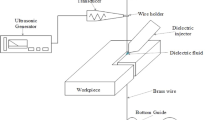Abstract
Wire electric discharge machining (WEDM) is a nontraditional machining process which shows high capability for improvement in the surface properties of the machined product as high-quality machined products has high demand in the manufacturing industry, and WEDM process is capable for machining of all sorts of conductive materials of any hardness. The presented work focuses on the formation of prediction model using deep learning feed forward back propagation neural network (FFBP ANN) for the WEDM process parameters which will give the user a choice for selecting the best process parameters as per their requirement. The proposed FFBP ANN model has six neurons, ten neurons, and two neurons in the input layer, hidden layer, and output layer, respectively, which will remove all the limitation of the previously developed models and conventional techniques for finding the best machining process parameters. Then, proposed model’s predicted values are compared with the experimental values and regression prediction model values for checking the capability of the proposed FFBP ANN model, and it is found that accuracy of the proposed model is higher than the regression prediction model. The average percentage error between the FFBP ANN-predicted values and the experimental values for cutting speed and surface roughness is 2.99 and 1.74%, respectively. The correlation coefficient between the FFBP ANN-predicted values and the experimental values is found to be 0.9909. Then, statistical validation of the proposed model is done, and the results showed that the FFBP ANN model has a statistically acceptable goodness of fit.
Access this chapter
Tax calculation will be finalised at checkout
Purchases are for personal use only
Similar content being viewed by others
References
Ho KH, Newman ST, Rahimifard S, Allen RD (2004) State of the art in wire electrical discharge machining (WEDM). Int J Mach Tools Manuf 44:1247–1259
Kant G, Singh K (2015) Predictive modelling and optimization of machining parameters to minimize surface roughness using artificial neural network coupled with genetic algorithm. Procedia CIRP 31:453–458
Vardhan MV, Sankaraiah G, Yohan M (2018) Prediction of surface roughness & material removal rate for machining of P20 steel in CNC milling using artificial neural networks. Mater Today Proc 5(9):18376–18382
Dinesh S, Vijayan V, Thanikaikarasan S, Sebastian PJ (2019) Productivity and quality enhancement in powder mixed electrical discharge machining for OHNS die steel by utilization of ANN and RSM modeling. J New Mater Electrochem Syst 22(1):33–43
Kumar Parida A, Maity K (2019) Modeling of machining parameters affecting flank wear and surface roughness in hot turning of Monel-400 using response surface methodology (RSM). Meas J Int Meas Confed 137:375–381
Thanh T, The N, Vu C, Dung Q (2020) Multi-responses optimization of finishing honing process for surface quality and production rate. J Brazilian Soc Mech Sci Eng 42(11):1–17
Raghavendra S, Sathyanarayana PS et al (2020) High speed machining of titanium Ti 6Al4V alloy components: study and optimisation of cutting parameters using RSM. Adv Mater Process Technol 1–14
Muthukrishnan N, Davim JP (2009) Optimization of machining parameters of Al/SiC-MMC with ANOVA and ANN analysis. J Mater Process Technol 209:225–232
Agatonovic-Kustrin S, Beresford R (2000) Basic concepts of artificial neural network (ANN) modeling and its application in pharmaceutical research. J Pharm Biomed Anal 22(5):717–727
Hossain S, Zhi O, Ismail Z, Noroozi S (2017) Artificial neural networks for vibration based inverse parametric identifications: a review. Appl Soft Comput J 52:203–219
Garg MP, Jain A, Bhushan G (2012) Modelling and multi-objective optimization of process parameters of wire electrical discharge machining using non-dominated sorting genetic algorithm-II. Proc Inst Mech Eng Part B J Eng Manuf 226:1986–2001
Author information
Authors and Affiliations
Corresponding author
Editor information
Editors and Affiliations
Rights and permissions
Copyright information
© 2022 The Author(s), under exclusive license to Springer Nature Singapore Pte Ltd.
About this paper
Cite this paper
Gupta, K., Goyal, K.K., Phanden, R., Rani, D. (2022). A Study on Wire Electric Discharge Machining Process Parameters Prediction Model Using Deep Learning Neural Network . In: Kumar, R., Ahn, C.W., Sharma, T.K., Verma, O.P., Agarwal, A. (eds) Soft Computing: Theories and Applications. Lecture Notes in Networks and Systems, vol 425. Springer, Singapore. https://doi.org/10.1007/978-981-19-0707-4_45
Download citation
DOI: https://doi.org/10.1007/978-981-19-0707-4_45
Published:
Publisher Name: Springer, Singapore
Print ISBN: 978-981-19-0706-7
Online ISBN: 978-981-19-0707-4
eBook Packages: Intelligent Technologies and RoboticsIntelligent Technologies and Robotics (R0)




